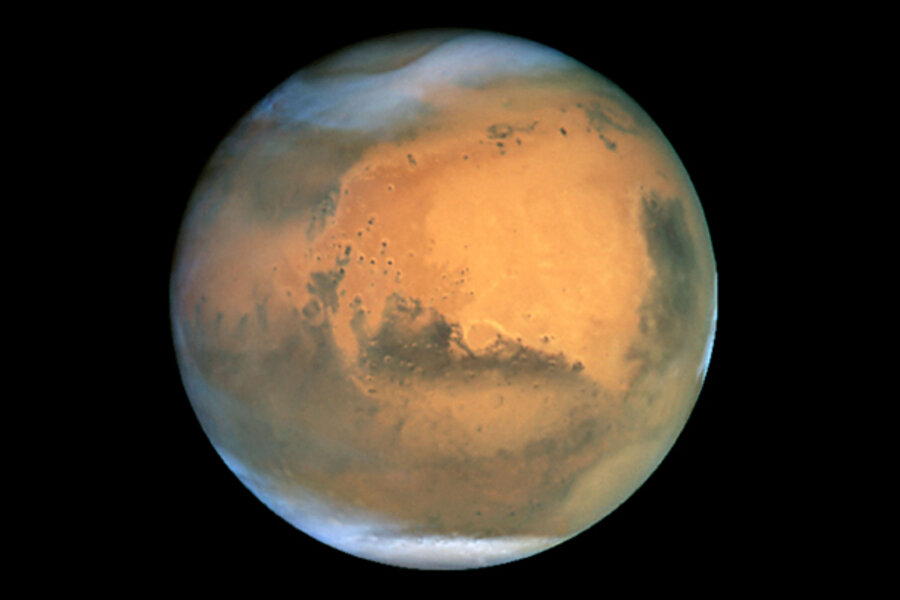Water on Mars first discovered 10 years ago. Is it still there?
Loading...
Ten years ago this week, news from Mars made a huge splash on Earth — water might still flow on the surface of the red planet. That news, announced by NASA, hinged on photos of newfound gullies etched across the Martian surface, and a decade of other water-on-Mars discoveries ensued. Yet even 10 years later definitive proof of flowing Mars water remains elusive.
The quest to find evidence of liquid water on Mars, and the surprises that have turned up along the way, have transformed our view of the red planet from a dry and dead planet to one where life might have flourished and even live still.
"We are definitely on the path to exploring the habitability of Mars — what it's been like in the past and even potentially now," said Michael Meyer, lead scientist for NASA's Mars Exploration Program. [Photos: Water on Mars imagined.]
IN PICTURES: Mars Spirit rover: What a long-range trip it's been
The big news
Scientists analyzing data from NASA's Mars Global Surveyor spacecraft 10 years ago found what appeared to be gullies formed by flowing water, as well as debris and mud deposits these flows may have left behind.
These features appeared so fresh that they might still be forming today, researchers said at the time. The changing appearance of gullies on Mars over time supported their findings, they later said.
NASA announced the news on June 22, 2000, with the research later appearing in that year's June 30 issue of the journal Science.
There is plenty of evidence that water formed vast oceans in the distant past on Mars, carving valleys and other features that are clearly apparent on its surface.
However, the possibility of liquid water on the red planet's surface today is perplexing, because it cannot survive there due to sub-zero temperatures and the thin Martian atmosphere. As such, the possibility of flowing water on the surface of Mars has been highly debated.
For instance, last year researchers suggested globs of salty water were seen on the legs of NASA's Phoenix Mars Lander. But others on the same team countered that the spots may have been frost instead.
There was no doubt that water ice was present at near the Phoenix lander – which set down in the Martian arctic. In fact, water ice has been found on Mars at the planet's poles, inside some craters and sitting beneath the surface across vast swaths of the Martian mid-latitude regions. But questions still remain on when water last flowed on the red planet's surface.
"There's been no smoking gun evidence yet as to whether liquid water has been on the surface of Mars in the recent past," Meyer said.
Challenging search
One of the main problems about proving whether or not water still flows on the surface of Mars "is that where we have seen gullies also tends to be where we don't want to land spacecraft," Meyer explained.
"The hope is that orbiter missions can catch something in the act involving liquid water near the surface today," he said. "We do suspect there's liquid water in the subsurface — it's just depends on how deep you have to go."
Europe's Mars Express spacecraft has been probing for hidden pockets of ice and liquid water using ground-penetrating radar. NASA's powerful Mars Reconnaissance Orbiter has also been searching for evidence of Mars' watery past from orbit.
One thing has become certain over the past decade: There was once a lot of water on Mars, and much frozen water remains hidden there.
"We've gone from suspecting there was water on Mars once upon a time to deciding there definitely was water, and not only that there was water, but lots of water," Meyer said. "Now with the Mars Reconnaissance Orbiter, we've found frozen water even at mid-latitudes, so the inventory of water on Mars is looking better and better as we learn more."
The excitement concerning water on Mars is rooted in how central we know water is to life on Earth.
"How much water has been on Mars, how long we think it was there and how many places might have had it makes a difference in how habitable we think it might have been," Meyer said.
Although research continues to look at water on Mars, "in many ways we are moving beyond specifically looking for water on Mars and more at what the consequences of water might be — for example, minerals formed in the presence of water, particularly maybe organic matter, which might have preserved what went on in early Mars," Meyer said. And, of course, the whole effort is aimed at determining whether life ever did, or does, exist on Mars.
"Currently we're holding landing site workshops for the Mars Science Laboratory, which is set to launch next year, for specific places to go to look at such minerals," he added.
- Gallery – Visions of Water on Mars
- Special Report: June 22, 2000 – Evidence of Water on Mars
- Ancient Mars Covered By Vast Ocean
IN PICTURES: Mars Spirit rover: What a long-range trip it's been





